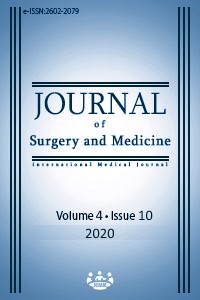May Covid-19 cause intracerebral hemorrhage in patients with cavernous malformation?
Keywords:
COVID-19, Haemangioma, CavernousAbstract
Coronavirus disease 2019 (COVID-19), caused by the SARS-CoV-2 virus, has become a global health threat. COVID-19 often involves the respiratory tract, however, it is also associated with several neurological conditions (seizures, convulsions, changes in consciousness, encephalitis, cerebral hemorrhage, and cerebral thrombosis). Cavernous malformations (CMs) are vascular lesions that occur in the central nervous system and the body. Symptomatic CMs most manifest through headaches, seizures, hemorrhage, or focal neurological deficits. The co-occurrence of COVID-19 and cavernous hemangioma hemorrhage has not been reported in the literature. The association between COVID-19 and intracerebral hemorrhage remains controversial. However, a relationship with COVID-19 infection in patients with intracerebral hemorrhage should always be considered during this pandemic. The case of a 37-year-old female patient is reported here. The patient presented to the emergency room with a headache that persisted for 2 days along with cavernous hemangioma hemorrhage and tested positive for COVID-19.
Downloads
References
Sahin AR, Erdogan A, Agaoglu PM, Dineri Y, Cakirci AY, Senel ME, et al. 2019 novel coronavirus (COVID-19) outbreak: a review of the current literature. EJMO. 2020;4:1–7. doi: 10.14744/ejmo.2020.12220.
Mao L, Jin H, Wang M, Hu Y, Chen S, He Q, et al. Neurologic manifestations of hospitalized patients with coronavirus disease 2019 in Wuhan, China. JAMA Neurol. 2020;77(6):683–90. doi: 10.1001/jamaneurol.2020.1127.
Moriarity JL, Clatterbuck RE, Rigamonti D. The natural history of cavernous malformations. Neurosurg Clin. 1999;10(3):411–7. doi: 10.1016/S1042-3680(18)30175-X.
Smith ER, Scott RM. Cavernous malformations. Neurosurg Clin North Am. 2010;21(3):483–90. doi: 10.1016/j.nec.2010.03.003.
Zhou F, Yu T, Du R, Fan G, Liu Y, Liu Z et al. Clinical course and risk factors for mortality of adult inpatients with COVID-19 in Wuhan, China: a retrospective cohort study. Lancet. 2020;395:1054–62. doi: 10.1016/S0140-6736(20)30566-3.
Aguilar MI, Brott TG. Update in intracerebral hemorrhage. Neurohospitalist. 2011;1(3):148–59. doi: 10.1177/1941875211409050.
Benger M, Williams O, Siddiqui J, Sztriha L. Intracerebral haemorrhage (ICH) and COVID-19: Clinical characteristics from a case series. Brain Behav Immunity. 2020 Jun 7. doi: 10.1016/j.bbi.2020.06.005 (Epub ahead of print)
Sharifi-Razavi A, Karimi N, Rouhani N. COVID-19 and intracerebral haemorrhage: causative or coincidental? New Microbes New Infect. 2020;35:100669. doi: 10.1016/j.nmni.2020.100669
Bohmwald K, Galvez N, Ríos M, Kalergis AM. Neurologic alterations due to respiratory virus infections. Front Cell Neurosci. 2018;12:386. doi: 10.3389/fncel.2018.00386
Md Noh MSF. COVID-19 and Cerebral Hemorrhage: Proposed Mechanisms, J Neuroradiol. 2020 Jun 1. doi: 10.1016/j.neurad.2020.05.007 (Epub ahead of print)
Levi M, Thachil J, Iba T, Levy JH. Coagulation abnormalities and thrombosis in patients with COVID-19. Lancet Haematol. 2020;7(6):e438–40. doi: 10.1016/S2352-3026(20)30145-9.
Downloads
- 1063 1160
Published
Issue
Section
How to Cite
License
Copyright (c) 2020 Ali Şahin, Şükrü Oral, Esma Eren
This work is licensed under a Creative Commons Attribution-NonCommercial-NoDerivatives 4.0 International License.
















